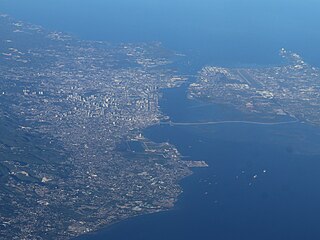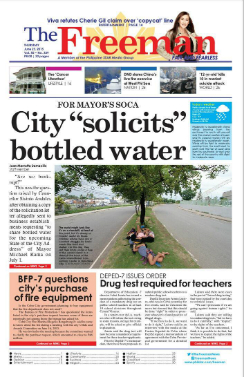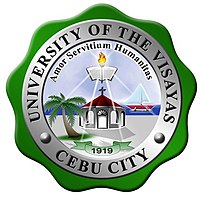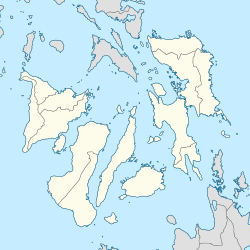
Cebu City, officially the City of Cebu, is a 1st class highly urbanized city in the Central Visayas region of the Philippines. It is the capital of the province of Cebu, where it is geographically located but is one of three cities that are administratively independent of the provincial government. According to the 2020 census, it has a population of 964,169 people, making it the sixth-most populated city in the nation and the most populous in the Visayas.

Mandaue, officially the City of Mandaue, is a 1st class highly urbanized city in the Central Visayas region of the Philippines. According to the 2020 census, it has a population of 364,116 people.

Dalaguete, officially the Municipality of Dalaguete, is a 1st class municipality in the province of Cebu, Philippines. According to the 2020 census, it has a population of 74,596 people.

Minglanilla, officially the Municipality of Minglanilla, is a 1st class municipality in the province of Cebu, Philippines. According to the 2020 census, it has a population of 151,002 people.

Cebu Normal University, also referred to by its acronym CNU, is a state research university in Cebu City, Cebu, Philippines established in 1902.

Metropolitan Cebu, or simply Metro Cebu,, is the main urban center of the province of Cebu in the Philippines. Metro Cebu is located along the central eastern portion of the island including the nearby island of Mactan. It accounts for 19.9 percent of the land area and 61.5 percent of the population of the entire province of Cebu.

The legislative districts of Cebu are the representations of the province of Cebu in the various national legislatures of the Philippines. At present, the province is currently represented in the House of Representatives of the Philippines by its seven congressional districts, with their respective representatives being elected every three years. Locally, the districts are also allotted two seats in the Cebu Provincial Board, with board members also being elected every three years.

The University of Cebu is a private, non-sectarian, coeducational basic and higher education institution in Cebu City, Philippines. It was founded in 1964 offering preschool, grade school, junior & senior high school, undergraduate degrees, and post-graduate degrees. It currently has five campuses.

DYET-TV is a television station in Metro Cebu, Philippines, serving as the Visayas flagship of the TV5 network. It is owned and operated by the network's namesake corporate parent; TV5 also provides certain services to RPTV affiliate DYKC-TV and One Sports outlet DYAN-TV under an airtime lease agreement with station owners Radio Philippines Network and Nation Broadcasting Corporation, respectively.

The Freeman is a daily English-language newspaper published in Cebu, Philippines. It is the longest-running newspaper in Cebu, first published on May 10, 1919. Since 2004, the newspaper has been published by the Philstar Media Group, publisher of the Manila-based newspaper, The Philippine STAR, with former owner Jose "Dodong" Gullas retaining editorial control over the newspaper. The motto of the newspaper is "Fair and fearless".
JRG Halad Museum is a musically-themed museum in Cebu City, Philippines that pays homage to the musical heritage of Cebu.
Local elections were held in Cebu on May 13, 2013, within the Philippine general election. Voters will select candidates for all local positions: a town mayor, vice mayor and town councilors, as well as members of the Sangguniang Panlalawigan, the vice-governor, governor and representatives for the six districts of Cebu. Incumbent governor Gwendolyn Garcia is barred for seeking another term because she is limited to three terms only.

Manuel Cabahug Briones was Filipino Visayan lawyer, judge, and politician from Cebu, Philippines. He was the first Supreme Court Associate Justice from Cebu, and he was a former Associate Justice of the Court of Appeals, two-term Senator, Member of the House of Representative for four consecutive terms, and editor from Cebu, Philippines.
Sotero "Terong" Barte Cabahug was a Filipino lawyer, legislator, politician, and civil servant from Mandaue, Cebu, Philippines. He was awarded Legion of Honor with the rank of Commander. He was governor of Cebu (1934–1937), member of the House of Representatives for Cebu's 2nd district for two consecutive terms (1928–1934), Secretary of Public Works and Communications (1945–1946), member of the Cebu Provincial Board (1952–1954), the 9th Secretary of National Defense (1954–1956), and associate justice of the Court of Appeals (1956–1961).
Vicente Low de la Serna was a Filipino lawyer, politician, and legislator. He was Cebu's 6th district's representative to the 8th Congress of the Philippines (1987–1992) and the governor of the province of Cebu, Philippines from 1992 until 1995.
Paulino Arandia Gullas was a Filipino Visayan lawyer, newspaper publisher, and legislator from Cebu, Philippines. He was the founder of The Freeman, Cebu's longest-running newspaper, served as member of the 7th Philippine Legislature for Cebu's 2nd district (1925–1927), Delegate to the 1934 Constitutional Convention, and member of the National Assembly during World War II.
Vicente Arandia Gullas was a Filipino writer, lawyer, and educator from Cebu, Philippines. Founder of the Visayan Institute, he introduced innovation in educational system through the establishment of working student and study-now-pay-later schemes and of satellite schools to allow students from locations outside Cebu City. In 2019, he was hailed as one of the top 100 Cebuano personalities.




















